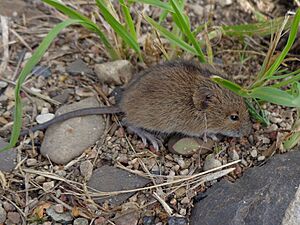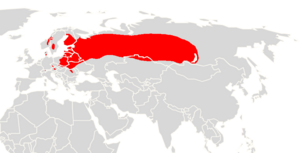Northern birch mouse facts for kids
Quick facts for kids Northern birch mouse |
|
|---|---|
 |
|
| Conservation status | |
| Scientific classification | |
| Genus: |
Sicista
|
| Species: |
betulina
|
 |
|
The northern birch mouse (Sicista betulina) is a small rodent that lives in forests and marshy areas across northern Europe and Asia. It's only about 5 to 8 cm long, not counting its tail, and weighs about as much as a few paper clips (5 to 13 grams). This little mouse spends its winters sleeping deeply in burrows, a process called hibernation. When it's awake, it enjoys eating young plant shoots, seeds, berries, and sometimes even insects.
Contents
What Does It Look Like?
The northern birch mouse is a tiny mouse known for its long tail. Its head and body are usually about 5 to 8 cm (2 to 3 inches) long. Its tail is even longer, measuring around 7.5 to 10.5 cm (3 to 4.25 inches). Adult mice weigh between 5 and 13 grams.
Their fur is yellowish-grey on top, with a brownish shine. Their belly is a lighter greyish-yellow. A special feature is a black stripe that runs down their back, all the way from their head to where their tail begins. If you ever hear one, it makes a high-pitched whistling sound!
Where Do Northern Birch Mice Live?
Northern birch mice can be found in many places, including Scandinavia, Central and Eastern Europe, and Northern Asia. Their main home stretches from the Baltic Sea region, Poland, and the Czech Republic, all the way east to Lake Baikal in Siberia. They also live from the Arctic Circle south to the Carpathian Mountains.
You might find smaller groups of them in Norway, Sweden, Denmark, Germany, and Austria. These mice like to live in coniferous forests (like pine forests), mixed woodlands, marshy forests, and damp, bushy grasslands. Sometimes, they even show up in fields where crops like cereal are grown.
Life and Habits of the Northern Birch Mouse
Northern birch mice mostly eat plants. They munch on buds, young shoots, grass seeds, and berries. But they also enjoy a tasty treat of earthworms, insects, and snails, often finding these under loose tree bark.
They are very good climbers! They can easily move around in trees and bushes. They use their five-toed feet to grip twigs and branches. Their long, flexible tail helps them balance and gives them extra support as they climb.
Nesting and Reproduction
During the summer, the northern birch mouse builds a cozy nest. They use dry plants and hide their nests in a bush, a clump of moss, or a patch of tall grass.
Breeding season is from May to August. After being pregnant for about 4 to 5 weeks, a mother mouse will have one litter of babies. She can have up to six young mice at a time.
Hibernation
When winter arrives, these mice go into a deep sleep called hibernation. They look for a safe, dry spot to sleep. This could be a natural crack in the ground, a burrow dug by another animal, or a spot on an embankment or in a bushy area. They might also choose a hollow tree, a tree stump, a fallen log, or a gap under a rock.
Their hibernation can last a long time, sometimes from October all the way until May! While they are hibernating, they wrap their tail in a spiral around their body.
Conservation Status
The northern birch mouse lives across a very large area. In Western Europe, it's not very common, and you'll find them in small, separate groups. But further east, there are many of them.
Scientists don't know exactly if their numbers are going up or down. However, the IUCN (International Union for Conservation of Nature) lists this species as being of "least Concern". This means they believe the mouse population is not decreasing so quickly that it needs more serious protection right now. There aren't any big, specific threats identified for this mouse. However, farming might affect their numbers in Germany, and cutting down forests could impact them in Romania.
See also


